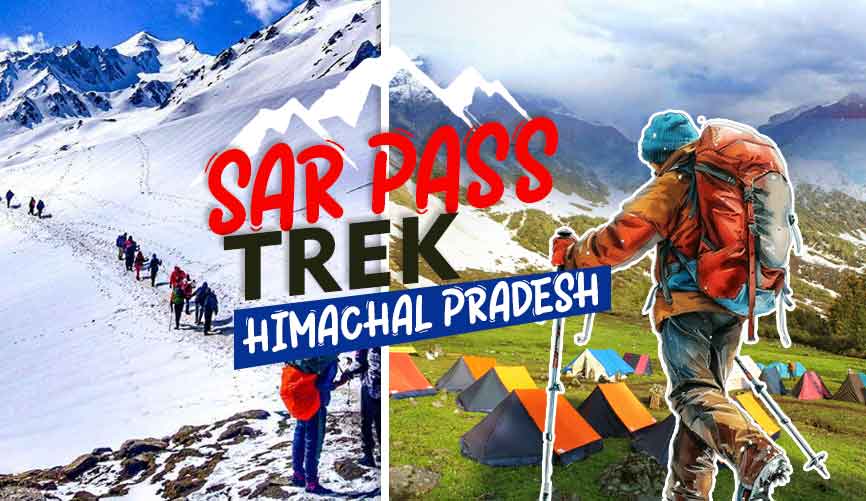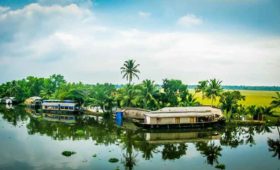The Sar Pass Trek, Kasol, is an amazing place that provides adventurous travelers with an exciting route in Himachal Pradesh. Sar Pass Trek, Kasol, located in Parvati Valley, is one of the perfectly balanced and designed trekking trails with a touch of adventure and spiritual touch. They are also popular among those who love trekking, whether as amateurs or those who have been trekking for some time. The path is among the pictorial landscapes of pine trees, colorful alpine meadows, snowy mountains, and typical Himalayan country roads.
Therefore, this has made this trek among some of the most popular adventure treks in the world. Sar pass trekking is also filled with literary beauty and requires effort to trek through high-altitude areas. In this blog, you’ll find everything from Sar Pass trek price, distance, itinerary, gear tips, best time to visit, and more.
Table of Contents
Sar Pass Trek Distance and Altitude
To clarify, the Sar Pass trek distance is around 48 kilometers. On average, it takes about four to five days to do the whole circuit.
- Starting Point: Kasol (1,580 m)
- Highest Point: Sar Pass (4,220 m)
- Total Elevation Gain: 2,600+ meters
This steady increase in elevation makes the Sar Pass Trekking perfect for those with moderate physical endurance and fitness.
What Is Sar Pass Trek Kasol?
The Sar Pass trek, Kasol, is an off-the-beaten-track through the mountains and is a high-altitude trek per se with an altitude of 13,800 ft or 4,200 meters. It is challenging but friendly to anyone who prefers a trek since it offers different challenges for its visitors. It is also important to note that in the native language, the word ‘Sar’ stands for ‘lake,’ the route takes its name from a small frozen lake that hikers traverse before ascending to the top.
It usually starts from Kasol, which is a small growing town renowned for its breathtaking beauty, vibrant Beatles, and squatting scene. From Kasol, this passes through beautiful towns like Grahan, gorgeous meadows, nice forests, and finally over the Sar Pass, which is usually under snow most of the time.
Why Choose the Sar Pass Trek?
1. Stunning Scenery
The Sar Pass trek is another thrilling experience that one must not miss, with excellent visuals at every glance. This can be achieved from the aerial view of the trek, which crosses through elongated pine forests and snowy meadows. Sar Pass offers a spectacular view of the valley under snow and is a delight for photographers. Other worthy attractions include several glacial lakes, waterfalls, and forests that make the trek enjoyable.
2. Cultural Experience
Nature, the majestic mountains, and the Austria of the East are offered to nature lovers in the Sar Pass Trek in Himachal Pradesh. It’s a cultural journey as well. It is a trail that will take you through different villages and enable you to get in touch with the people and their simple livelihood. Visiting the towns through which the trails pass is also beneficial since the people of the Parvati Valley are very friendly and friendly and you get to learn about their culture and way of living.
3. Adventurous Terrain
For adventure lovers, the Sar Pass Trek, Kasol, can be described as one of the best. This tour involves宁 some steep climbs, snowfields, and rocky parts. But it’s quite enjoyable since every step leads you to the fabulous views and the feeling of conquering the Sar Pass. The snowy background increases the trace of adventure, which implies undertaking a specific risk.
4. Suitable for ALL Levels of Trekkers
The beauty of the Sar Pass is that it is considered easy for trekkers of all abilities. Of course, the trek is muscular, but it does not involve actual mountain climbing and, hence, does not need technical climbing equipment. Notably, the trails are well-documented, and experienced individuals usually lead the treks; therefore, it is considerably appropriate for first-time high-altitude trek enthusiasts. On the same note, able trekkers can have the test and the scenery that the journey provides.
Best Time to do the Sar Pass Trek
The Sar Pass trek is best undertaken in the summer season, which is between May end and June and between September end and October. The weather is fine now, and there is snow on the trails so it can be an enjoyable but not very difficult trip.
Trekking in May or June can traverse the remainder of the winter snow. By September, the snow is melting, and you are left with green leaves, which are beautiful in their own way but not as fascinating as the snow.
What Is the Sar Pass Trek Price?
The Sar Pass trek price varies depending on operators and inclusions. It is usually between 6,000 to 9,000 Rupees.
This usually includes:
- Meals and tents during the trek
- Guides and permits
- Transportation from Kasol to Barshaini, which is the endpoint of the trek.
Private or luxury treks could be more expensive. But, several low-cost packages can be availed from reputed trekking groups.
How to Reach Kasol?
Kasol, the starting point of the walk, is easily accessible by road from major cities. Here’s how to get there:
By Air: The closest airport in Bhunter (Kullu Manali Airport), which is about 31 Km from Kasol. From Bhuntar, one needs to take a taxi or a bus to reach Kasol.
By Rail: The closest railhead is at Pathankot, from the spot about 150 kilometers away. After reaching Pathankot, one can hire a taxi or take a bus to Kasol.
By Roadways: Kasol is well connected by buses to and from Delhi, Chandigarh, and Manali. There are frequent buses to these cities from which one can take local transport, such as a bus or taxi, to reach Kasol through Bhuntar.
Highlights of the Sar Pass Trek
The Sar Pass Trekking is more famous for the spectacular view of natural beauty and adventurous trekking. Below are some of the features that make it one of the most preferred treks in Himachal Pradesh:
1. Kasol Village
The trek starts at Manikaran, and the first place of interest is the small town of Kasol, which is located in the Parvati district. Kasol is one of the most famous for its charming beauty and is suitable for acclimatization before embarking on trekking activities. The village has also become a favorite hub for hikers and tourists, with tents of food joints providing teas and delicious Kenyan dishes among a list of other foods worldwide.
2. Trekking through Dense Forests
When you start the Sar Pass trekking, you will likely come across pine, oak, and rhododendron forests. The rising from the ground and dense forest offer an ideal terrain to see some animals such as the Himalayan Monal, pheasants, other small birds, and many others. The bird singing and the fresh breeze adding to this make it even more enjoyable.
3. Climbing to Sar Pass
The climax of the trek is, undoubtedly, the ascent of the Sar Pass. The last part is quite steep and always covered with snow, and it can be quite tiring, but once up to the summit, it is a fantastic feeling. Starting at the top, one can view snowy mountains, deep valleys, and glaciers. It is one of the best spots where one can take good pictures.
4. The Descent to Barshaini
With the completion of Sar Pass trekking, the track is taken downhill to Barshaini. The descent is also quite thrilling as it presents an opportunity to enjoy the scenery from another perspective. Moving downwards, adverse to the slope, you can see the power of nature revealing the surroundings of the Parvati Valley.
The Sar Pass Trek Itinerary:
Day 1: Arrival in Kasol
The trip starts at the highly popular town of Kasol, boastingly referred to as the ‘Amsterdam of India’ due to its relaxed vibes and beautiful landscapes. Pass the day roaming around the various cafés of Kasol while discussing with other trekkers and enjoying the sight of the Parvati River nearby.
Day 2: Kasol to Grahan Village (9 km; 4-5 hours)
The first day of trekking begins! You will move from Kasol to Grahan Village, an extremely beautiful village nestling in the mountains. The trail is easy, passing through dense pine jungles and over the Grahan Nalah kuccha bridge. Grahan is a complete village with typical Himachali stone houses and paddy terrains, which helps travelers get rid of urban trappings.
Day 3: Grahan to Min Thach (7 km/4-5 hours)
The second day of hiking is somewhat more difficult for you: you’ll have to climb deep into the woods to get to Min Thach. The word ‘Thach’ in the local language means a stretch of meadows, and on arriving at Min Thach, you will find massive, undulating, extensive green meadows with a fantastic view of snow-capped Mountains.
Day 4: Min Thach to Nagaru (9 km; 5-6 hours)
This day can only be described as exciting yet tiring at the same time. As you proceed towards Nagaru Camp, you find the gradient of the road increases, and the carriageway becomes much narrower. Besides this, it is positioned at a high altitude. The landscape starts to become different, and we expect to traverse some snowy ground. It is cold at night in Nagaru, but the sights to behold here embrace the numerous surrounding peaks.
Day 5: Nagaru to Sar Pass to Biskeri Thatch (13 km; 7-8 hours)
This is the kind of day you have been waiting for: when you will cross Sar Pass. It is the beginning of the day, and one wakes up a little early in the morning, and then one has to climb a steep snow-covered slope before getting to the pass. This is because, once at the top, great views are in store from this mountain that none can resist. Finally, the downslope is exhilarating as it goes down the snowy slopes to Biskeri Thatch. Sledding on the snowy surface is one of the most enjoyable activities of the whole story.
Day 6: Biskeri Thatch to Barshaini (9 km, 4-5 hours), then drive to Kasol.
On the last day, a few hours of trek take you through dense green forests and babbling brooks to reach the village of Barshaini. From here, you can get an auto-rickshaw to Kasol. By the time the water rises, it indicates icy tracks instead of the beautiful meadow for what has been an unforgettable, magnificent walk.
What to Pack for the Sar Pass Trek?
It is essential to pack appropriately during a trekking expedition to ensure the journey is as comfortable as possible. Here is a list of essentials:
- Trekking shoes: A good pair of waterproof shoes with high ankle support should be worn.
- Warm Clothing: The climate could be quite cold at certain times of the year and even more so at higher altitudes. Pack some thermals, a down jacket, gloves, and a headscarf.
- Rain Gear: It does not rain much in the mountains, but it does happen, and hence, a good waterproof jacket and a rain cover for the bag are advisable.
- Trekking poles: They will be helpful for you when moving up the steep slopes and down when into the snowy areas.
- First Aid Kit: Basic medications for altitude sickness, headaches, and stomach problems, as well as bandages and antiseptic creams.
- Sunscreen and sunglasses: In many places, the sun will be hot, and naked eyes will be at risk for sunburn and risk from the glare of snow.
Essential Things To Remember:
- Acclimatize well: The trek takes you to higher altitudes, so you need to give yourself some time to adapt. Therefore, the participants should drink plenty of water and avoid rushing to complete the trek.
- Trek in Groups: It is always advisable to trek with other people, especially when you do not have experience. It is also possible to attend several guided trips that will prepare all the details for you.
- Respect nature: Keep the route clean and don’t trash. The mountains are natural and thus should remain natural; our duty is to ensure they will continue being so.
- Physical Fitness: Although the journey is average, you should have some essential physical fitness. At least 2-3 weeks of aerobics, strength training, and flexibility exercise routines are sufficient.
Final Words
The Sar Pass trek, Kasol, is not a trek, just a delightful journey that will remain imprinted in your heart once you start. These views, companionship with other hikers, the joy of traversing the snow line, and the pleasure of being in the middle of stunning nature make it an unforgettable experience.
There is more to discover around the turn, with a waterfall, meadow, or towering mountains covered in snow. The trek to Sar Pass tests one’s spirit and endurance to offer one of the most amazing Himalayan treks.
Frequently Asked Questions About Sar Pass Trek
The Sar Pass trek is classified as a moderate trek. This mainly has inclined ways, but in some instances, those are steep, especially when the group crosses the Sar Pass mid-trekking day. Essential fitness is required, but it suits those with previous trekking experience.
Sar Pass trek is around 48 KM, and generally, the trekking period is 6 days, excluding the time for reaching and leaving Kasol. The daily traveling distance covers from 7 to 13 kilometers.
The ideal time to carry out the Sar Pass Trek is from May to June and September to October. It is still not too hot, the sky is clear, and there is a small amount of snow during these months, making hiking fun.
The variation in height can take a toll even on the local climate. Kasol and Graham are relatively warmer and quite fine. Still, Nagaru and Sar Pass areas may be very cold, especially at night, with temperatures sometimes getting to sub-zero levels. Snow is common during early May and June, especially in the higher elevations.
Altitude sickness is possible as the trail reaches a maximum of 13,800 feet. To avoid the high risk, one should appropriately acclimate themselves, ensure they are well-hydrated, and avoid exerting too much in the first few days of the trekking expedition. You should consult your doctor if you have any concerns about trekking, especially in the higher regions.
Of course, going solo is possible, but traveling in groups or with a guide is more advisable if you are not an experienced trekker. This may be very important in an emergency, and always having partners makes the trip more exciting.




